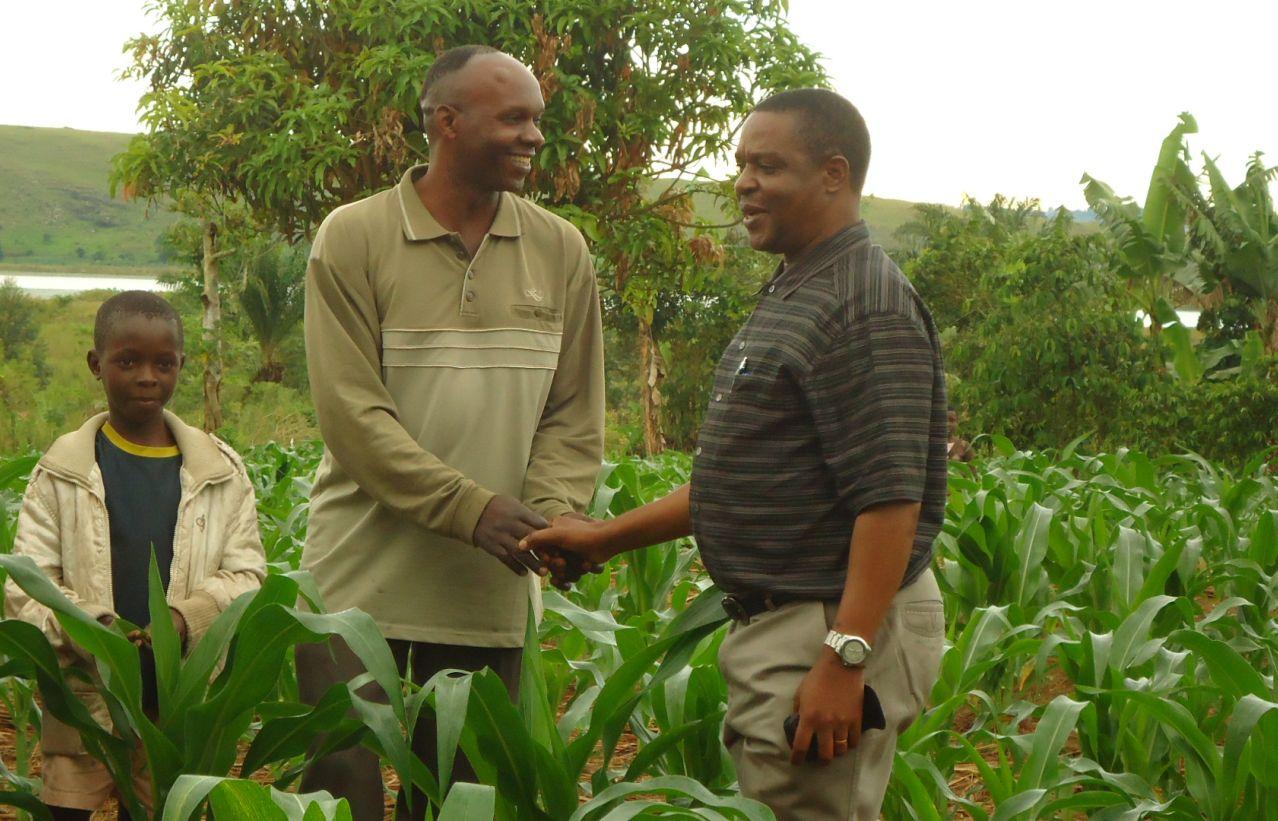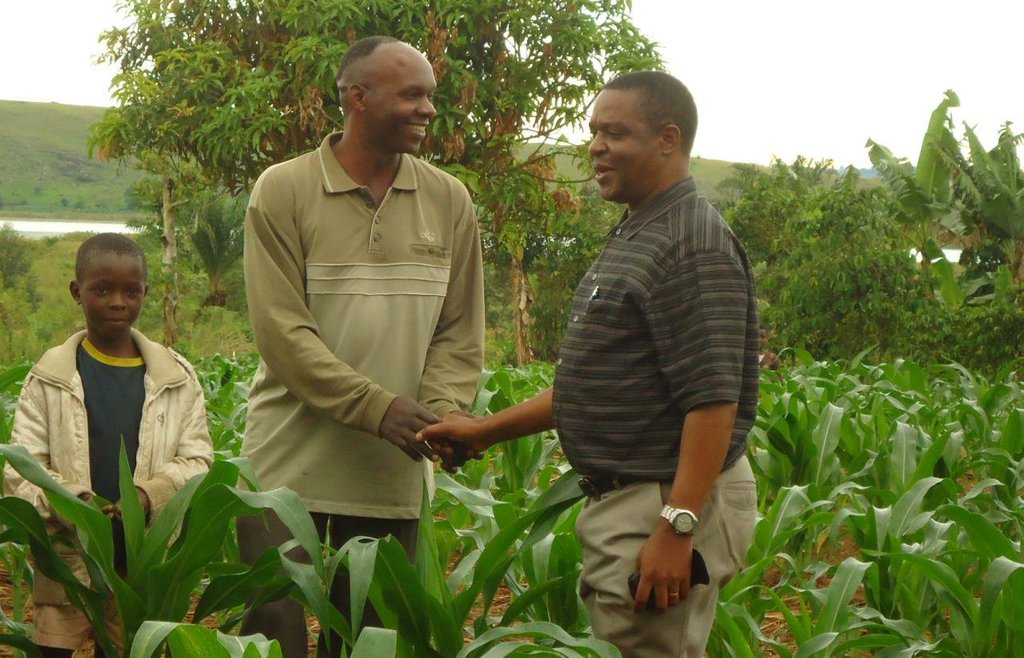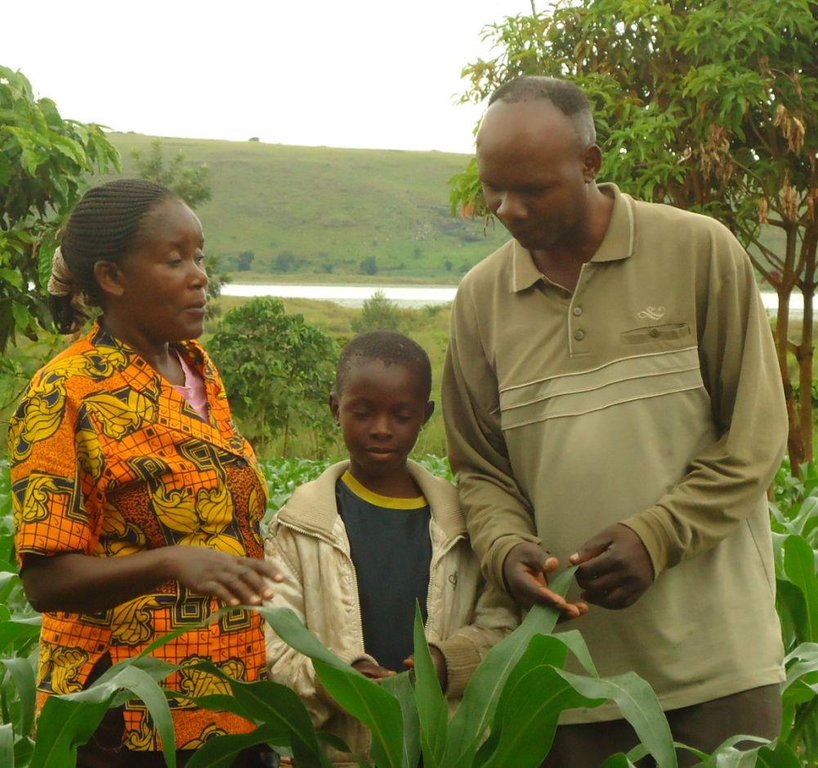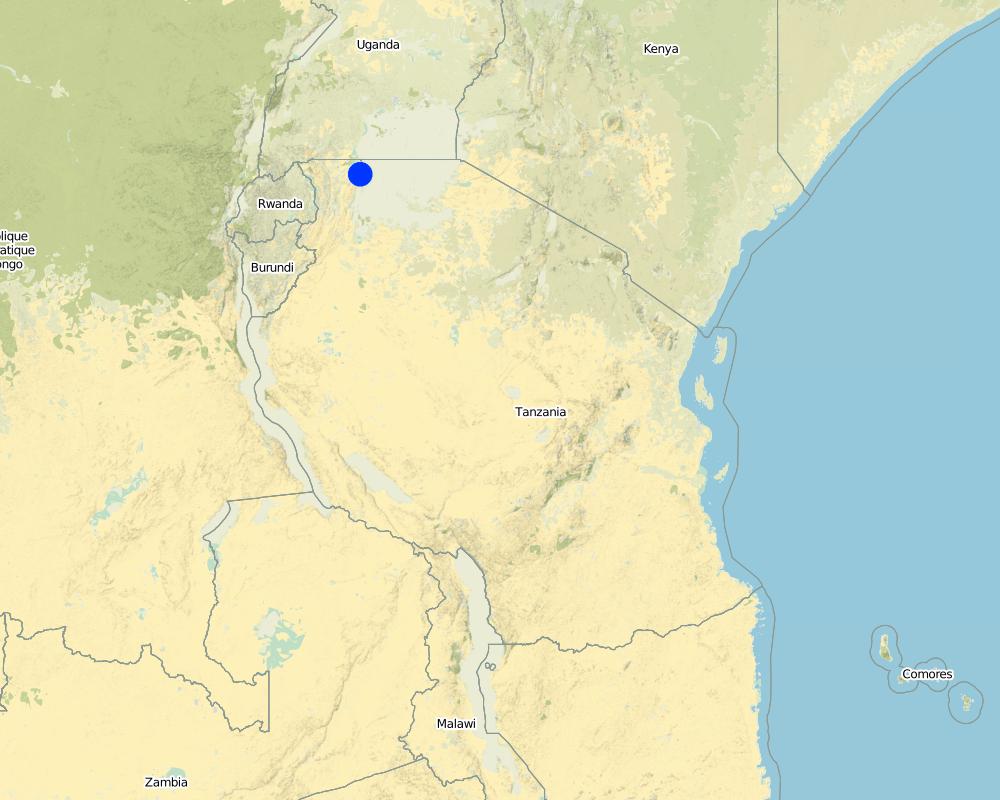Grass mulch combined with cow dung, Triple Supper Phosphate and Calcium Ammonium Nitrate in maize production. [แทนซาเนีย]
- ผู้สร้างสรรค์:
- การอัพเดท:
- ผู้รวบรวม: Godfrey Baraba
- ผู้เรียบเรียง: –
- ผู้ตรวจสอบ: Ursula Gaemperli, Fabian Ottiger
Matandazo ya nyasi katika kilimo cha mahindi yaliyolishwa mbloea.
technologies_1199 - แทนซาเนีย
ดูส่วนย่อย
ขยายทั้งหมด ย่อทั้งหมด1. ข้อมูลทั่วไป
1.2 รายละเอียดที่ติดต่อได้ของผู้รวบรวมและองค์กรที่เกี่ยวข้องในการประเมินและการจัดเตรียมทำเอกสารของเทคโนโลยี
ผู้เชี่ยวชาญ SLM:
Nkuba Julitha
Bukoba District Council
แทนซาเนีย
ผู้เชี่ยวชาญ SLM:
ชื่อขององค์กรซึ่งอำนวยความสะดวกในการทำเอกสารหรือการประเมินเทคโนโลยี (ถ้าเกี่ยวข้อง)
Missenyi District Council (Missenyi District Council) - แทนซาเนียชื่อขององค์กรซึ่งอำนวยความสะดวกในการทำเอกสารหรือการประเมินเทคโนโลยี (ถ้าเกี่ยวข้อง)
Bukoba district council (Bukoba district council) - แทนซาเนีย1.3 เงื่อนไขการใช้ข้อมูลที่ได้บันทึกผ่านทาง WOCAT
วันที่เก็บรวบรวมข้อมูล(ภาคสนาม) :
29/05/2014
ผู้รวบรวมและวิทยากรหลักยอมรับเงื่อนไขเกี่ยวกับการใช้ข้อมูลที่ถูกบันทึกผ่านทาง WOCAT:
ใช่
1.4 การเปิดเผยเรื่องความยั่งยืนของเทคโนโลยีที่ได้อธิบายไว้
เทคโนโลยีที่ได้อธิบายไว้นี้เป็นปัญหาของความเสื่อมโทรมโทรมของที่ดินหรือไม่ จึงไม่ได้รับการยอมรับว่าเป็นเทคโนโลยีเพื่อการจัดการที่ดินอย่างยั่งยืน:
ไม่ใช่
2. การอธิบายลักษณะของเทคโนโลยี SLM
2.1 การอธิบายแบบสั้น ๆ ของเทคโนโลยี
คำจำกัดความของเทคโนโลยี:
Is the spread of dry Hyperrhamia rufa across the slope combined with manures, Calcium Ammonia Nitrate and Triple Supper Phosphate in maize production.
2.2 การอธิบายแบบละเอียดของเทคโนโลยี
คำอธิบาย:
The spread of dry Hyperrhamia rufa 15cm thickness across the slope combined with manures, TSP and CAN in maize production technology is applied on annual cropland for reduced declining soil fertility, reduced soil erosion and improved soil moisture content in the sustainable land agro-ecosystem management. The activities to implement the technology includes to slush bushes and cut grasses using sickles , to cultivate the land using hand hoes, to measure spacing demarcate and dig holes using hand hoes, to mix manure, soils and TSP in a 5cm depth hole using hands, to spread grass mulch using hands, to plant maize seeds using hand hoes, to apply CAN at week four after planting using hands, to weed the whole field using hands, to apply a mixture of ashes and pepper on the tip, closed tip leaf to control maize stock-bores and to harvest and trush using hands
This technology is applied on annual cropland using agronomic measures in the sub humid climatic zone. The slope category of that land is gentle, characterized of loam sandy soil textures with medium soil depth.
The technology is applied by Individual / household, Small scale land users, common / average land users, men and women. The Land ownership is individual, not titled and Land use rights is individual as well. Water use rights is open access (unorganized).
The relative level of wealth categorized as, rich, which represents 20% of the land users and own 32% of the total area. Average, which represents 64% of the land users and own 64% of the total area. Poor, which represents 20% of the land users and own 4% of the total area.
The technology was introduced in 2012 by TAMP -Kagera using FFS in the community integrated catchment approach.
To implement the technology it was calculated to be US$ 57.059 for establishment and US$ 1,923.36 maintenance costs.
Purpose of the Technology: The major purpose of the technology is to prevent loss of top soil, to improve soil fertility decline and reduced organic matter content on the annual cropland with a sustainable land management to improve community livelihood.
Establishment / maintenance activities and inputs: This technology has no establishment activities as a common phenomena for all Agronomic measures. The maintenance activities of the technology includes; To slush bushes and cut grasses using sickles in Late August, To cultivate the land using hand hoes in Earl September, To measure spacing, demarcate and dig holes using hand hoes in earl September, To mix manure, soils and TSP in a 5cm deep hole using hands in mid september, To spread dry Hyperrhamia rufa using hands mid September, To plant maize seeds using hand hoes Late September, To apply CAN at week four after planting using hands in mid October, To weed the whole field twice using hands in early November and early February , To apply a mixture of ashes and pepper on the top openleaf to control maize stock-bores, To harvest and trash maize cobs using hands in Late February redy for marketing in late May.
To perform the maintenance activities the following inputs required; Labour, tools, seeds, fertilizer, biocides and compost/manure. All inputs can cost a total of US$ ...........0 per hector per season.
The dry Hyperrhamia rufa mulch in the Zea maize pure stand complemented withi cow dung, TSP and CAN introduce in April 2012 by TAMP -Kagera in the Butulage catchment.
Natural / human environment: This technology is applied on the cropland type in the subhumid. The landform of this catchment is plain and footslpoes with gentle slope. It is obvious that, the land is prone to sheath erosion, soil fertility decline and reduced organic matter content. However, the cause of these types of land degradation includes direct (human and natural) and indirect (land use supporting system). The technology is tolerant of seasonal rainfall decrease and drought or dry spell climatic extremes. On another hand the technology is sensitive to foods where excess water will lodge and damage the maize roots.
The land ownership is individual not titled and catergorised in small scale farmers who practiced mixed production mode. The wealth of the people applying this technology can be categorized as poor, average and rich according to land ownership. The poor repents 20% of land users and own 4% of the cropland area. The average category represents 64% of the land users and own 64% of the cropland area. The rich category represents 20% of cropland users and own 32% of the cropland.
2.3 รูปภาพของเทคโนโลยี
2.5 ประเทศภูมิภาค หรือสถานที่ตั้งที่เทคโนโลยีได้นำไปใช้และได้รับการครอบคลุมโดยการประเมินนี้
ประเทศ:
แทนซาเนีย
ภูมิภาค/รัฐ/จังหวัด:
Tanzania
ข้อมูลจำเพาะเพิ่มเติมของสถานที่ตั้ง :
Bukoba D.C
Map
×2.6 วันที่การดำเนินการ
ถ้าไม่รู้ปีที่แน่นอน ให้ระบุวันที่โดยประมาณ:
- น้อยกว่า 10 ปี (ไม่นานนี้)
2.7 คำแนะนำของเทคโนโลยี
ให้ระบุว่าเทคโนโลยีถูกแนะนำเข้ามาอย่างไร:
- ทางโครงการหรือจากภายนอก
ความคิดเห็น (ประเภทของโครงการ เป็นต้น) :
TAMP -Kagera in collaboration with Bukoba District council facilitated a group of FFS members to combat the land degradation problems identified and solutions prioritised by introducing the Grass mulch with manure, TSP AND CAN Technology in April 2012.
3. การจัดประเภทของเทคโนโลยี SLM
3.1 วัตถุประสงค์หลักของเทคโนโลยี
- ปรับปรุงการผลิตให้ดีขึ้น
- ลด ป้องกัน ฟื้นฟู การเสื่อมโทรมของที่ดิน
- สร้างผลกระทบทางด้านเศรษฐกิจที่เป็นประโยชน์
3.2 ประเภทของการใช้ที่ดินในปัจจุบันที่ได้นำเทคโนโลยีไปใช้

พื้นที่ปลูกพืช
- การปลูกพืชล้มลุกอายุปีเดียว
- การปลูกพืชยืนต้นที่ไม่มีเนื้อไม้
พืชหลัก (พืชเศรษฐกิจและพืชอาหาร):
Major cash crop: Beans, Coffee
Major food crop: Maize, Banana
Other crops: Sweet potatoes, vegetables, fruits
แสดงความคิดเห็น:
Major land use problems (compiler’s opinion): Without the land conservation there will be declining soil fertility, excessive drought, sheath erosion and plant moisture stresses.
Major land use problems (land users’ perception): Declining soil fertility, moisture stress and maize stock-bores.
3.3 ข้อมูลเพิ่มเติมเกี่ยวกับการใช้ที่ดิน
การใช้น้ำของที่ดินที่มีการใช้เทคโนโลยีอยู่:
- จากน้ำฝน
จำนวนของฤดูเพาะปลูกต่อปี:
- 1
ระบุ:
Longest growing period in days: 120. Longest growing period from month to month: september to December Second longest growing period in days: 90 Second longest growing period from month to month: March to May
3.4 กลุ่ม SLM ที่ตรงกับเทคโนโลยีนี้
- การจัดการความอุดมสมบรูณ์ของดินแบบผสมผสาน
3.5 กระจายตัวของเทคโนโลยี
ระบุการกระจายตัวของเทคโนโลยี:
- กระจายไปอย่างสม่ำเสมอในพื้นที่
ถ้าหากว่าเทคโนโลยีได้มีการกระจายออกไปอย่างสม่ำเสมอในพื้นที่ ให้ระบุปริมาณพื้นที่ที่ได้รับการครอบคลุมถึง:
- < 0.1 ตร.กม.(10 เฮกตาร์)
แสดงความคิดเห็น:
12 household members applied the technology on average farm size of 0.66ha during the farmer field school implementation in Butulage catchment.
3.6 มาตรการ SLM ที่ประกอบกันเป็นเทคโนโลยี

มาตรการจัดการพืช
- A1: พืช/สิ่งปกคลุมดิน
- A2: อินทรียวัตถุในดิน/ความอุดมสมบูรณ์ในดิน
- A3: การรักษาหน้าดิน
แสดงความคิดเห็น:
Type of agronomic measures: early planting, mulching, manure / compost / residues, mineral (inorganic) fertilizers
3.7 รูปแบบหลักของการเสื่อมโทรมของที่ดินที่ได้รับการแก้ไขโดยเทคโนโลยี

การกัดกร่อนของดินโดยน้ำ
- Wt (Loss of topsoil): การสูญเสียดินชั้นบนหรือการกัดกร่อนที่ผิวดิน

การเสื่อมโทรมของดินทางด้านเคมี
- Cn (Fertility decline): ความอุดมสมบูรณ์และปริมาณอินทรียวัตถุในดินถูกทำให้ลดลงไป (ไม่ได้เกิดจากสาเหตุการกัดกร่อน)

การเสื่อมโทรมของดินทางด้านชีวภาพ
- Bl (Loss of soil life): การสูญเสียสิ่งมีชีวิตในดิน
แสดงความคิดเห็น:
Main causes of degradation: soil management (Continous land tillage i.e. cultivation is done at every planting season), change of seasonal rainfall (Rain seasons are unpredictable now days.), droughts (The area experiences irregular droughts.), population pressure (Increased population density has rendered all productive area to occuppied, therefore people were forced to use marginal land for crop production.), labour availability (Hired labour is very cheap to cultivate in marginal land.)
Secondary causes of degradation: education, access to knowledge and support services (Low and ineffective primary education provided, Inadequety agriculture advisory staffing)
3.8 การป้องกัน การลดลง หรือการฟื้นฟูความเสื่อมโทรมของที่ดิน
ระบุเป้าหมายของเทคโนโลยีกับความเสื่อมโทรมของที่ดิน:
- ป้องกันความเสื่อมโทรมของที่ดิน
4. ข้อมูลจำเพาะด้านเทคนิค กิจกรรมการนำไปปฏิบัติใช้ ปัจจัยนำเข้า และค่าใช้จ่าย
4.2 ข้อมูลจำเพาะด้านเทคนิคและการอธิบายแบบแปลนทางเทคนิค
Technical knowledge required for field staff / advisors: low (Agronomy principles are taught at colleges.)
Technical knowledge required for land users: moderate (The use of correct ratios and measurement of fertilizers not common to farmers.)
Main technical functions: control of raindrop splash, improvement of ground cover, increase in organic matter, increase / maintain water stored in soil
Secondary technical functions: control of dispersed runoff: impede / retard
Early planting
Material/ species: Zea maize
Quantity/ density: 0.025
Remarks: 70cm plant to plant by 90cm row to row.
Mulching
Material/ species: dry Hyperrhamia ruffa
Quantity/ density: 1500
Remarks: 15cm thickness, 5cm from the plant and across the slope.
Manure / compost / residues
Material/ species: cow dung
Quantity/ density: 18.518
Remarks: Tharough mixed with soil in a 5cm hole on month prior planting.
Mineral (inorganic) fertilizers
Material/ species: Tripo supper Phosphate and Calcium Ammonium Phosphate
Quantity/ density: 0.1851
Remarks: 5gm per plant at planting and dressing stage.
4.3 ข้อมูลทั่วไปเกี่ยวกับการคำนวณปัจจัยนำเข้าและค่าใช้จ่าย
อื่นๆ หรือสกุลเงินประจำชาติ (ระบุ):
Tshs
ระบุอัตราแลกเปลี่ยนจากดอลลาร์สหรัฐเป็นสกุลเงินท้องถิ่น (ถ้าเกี่ยวข้อง) คือ 1 เหรียญสหรัฐ =:
1700.0
ระบุค่าเฉลี่ยของค่าจ้างในการจ้างแรงงานต่อวัน:
1.76
4.4 กิจกรรมเพื่อการจัดตั้ง
| กิจกรรม | ประเภทของมาตรการ | ช่วงเวลาดำเนินการ | |
|---|---|---|---|
| 1. | handhoes | มาตรการอื่น ๆ | |
| 2. | machete | มาตรการอื่น ๆ | |
| 3. | sickles | มาตรการอื่น ๆ | |
| 4. | tape measures | ด้วยการจัดการ |
4.5 ค่าใช้จ่ายของปัจจัยนำเข้าที่จำเป็นสำหรับการจัดตั้ง
| ปัจจัยนำเข้า | หน่วย | ปริมาณ | ค่าใช้จ่ายต่อหน่วย | ค่าใช้จ่ายทั้งหมดต่อปัจจัยนำเข้า | %ของค่าใช้จ่ายที่ก่อให้เกิดขึ้นโดยผู้ใช้ที่ดิน | |
|---|---|---|---|---|---|---|
| อุปกรณ์ | Handhoes | pieces | 16.0 | 2.94 | 47.04 | 100.0 |
| อุปกรณ์ | Machete | pieces | 16.0 | 1.17625 | 18.82 | 100.0 |
| อุปกรณ์ | Sickles | pieces | 16.0 | 0.47 | 7.52 | 100.0 |
| อุปกรณ์ | tape measures | pieces | 1.0 | 11.76 | 11.76 | |
| ค่าใช้จ่ายทั้งหมดของการจัดตั้งเทคโนโลยี | 85.14 | |||||
แสดงความคิดเห็น:
Duration of establishment phase: 1 month(s)
4.6 การบำรุงรักษาสภาพหรือกิจกรรมที่เกิดขึ้นเป็นประจำ
| กิจกรรม | ประเภทของมาตรการ | ช่วงระยะเวลา/ความถี่ | |
|---|---|---|---|
| 1. | To slush bushes and cut grasses using sickles | จัดการพืช | late august |
| 2. | To cultivate the land using hand hoes | จัดการพืช | early september |
| 3. | To measure spacing demarcate and dig holes using hand hoes. | จัดการพืช | Early September |
| 4. | To mix manure, soils and TSP in a 5cm depth hole using hands. | จัดการพืช | Mid September |
| 5. | To spread grass mulch using hands. | จัดการพืช | Mid September |
| 6. | To plant maize seeds using hand hoes. | จัดการพืช | Late September |
| 7. | To apply CAN at week four after planting using hands. | จัดการพืช | Mid October |
| 8. | To weed the whole field using hands. | จัดการพืช | Early Nov & Early Jan |
| 9. | To apply a mixture of ashes and pepper on the tip closed tip leaf to control maize stock-bores. | จัดการพืช | Mid November |
| 10. | To harvest and trush using hands | จัดการพืช | February |
4.7 ค่าใช้จ่ายของปัจจัยนำเข้าและกิจกรรมที่เกิดขึ้นเป็นประจำที่ต้องการการบำรุงรักษา (ต่อปี)
| ปัจจัยนำเข้า | หน่วย | ปริมาณ | ค่าใช้จ่ายต่อหน่วย | ค่าใช้จ่ายทั้งหมดต่อปัจจัยนำเข้า | %ของค่าใช้จ่ายที่ก่อให้เกิดขึ้นโดยผู้ใช้ที่ดิน | |
|---|---|---|---|---|---|---|
| แรงงาน | Slush bushes and cut grasses using sickles | person/days | 20.0 | 1.7645 | 35.29 | 100.0 |
| แรงงาน | Cultivate the land using hand hoes | person/days | 66.0 | 1.78 | 117.48 | |
| แรงงาน | Measure spacing demarcate and dig holes using hand hoes | person/days | 4.0 | 1.7 | 6.8 | |
| แรงงาน | Labour: Harvest and trush using hands | person/days | 225.0 | 1.7647 | 397.06 | |
| อุปกรณ์ | Polythene bags | pieces | 10.0 | 0.588 | 5.88 | |
| วัสดุด้านพืช | Grass mulch | bundles | 1500.0 | 0.29412 | 441.18 | |
| วัสดุด้านพืช | Seeds | kg | 25.0 | 2.9412 | 73.53 | |
| ปุ๋ยและสารฆ่า/ยับยั้งการเจริญเติบโตของสิ่งมีชีวิต (ไบโอไซด์) | Fertilizer | kg | 185.0 | 0.97 | 179.45 | |
| ปุ๋ยและสารฆ่า/ยับยั้งการเจริญเติบโตของสิ่งมีชีวิต (ไบโอไซด์) | Mixture of ashes and pepper | tons | 18.518 | 0.14688 | 2.72 | |
| ปุ๋ยและสารฆ่า/ยับยั้งการเจริญเติบโตของสิ่งมีชีวิต (ไบโอไซด์) | Compost/manure | tons | 18.518 | 29.412 | 544.65 | |
| อื่น ๆ | Labour: Mix manure, soils and TSP in a 5cm depth hole using hands. | person/days | 12.0 | 1.7 | 20.4 | |
| อื่น ๆ | Labour: Spread grass mulch using hands. | person/days | 15.0 | 1.76 | 26.4 | |
| อื่น ๆ | Labour: Plant maize seeds using hand hoes | person/days | 4.0 | 1.7 | 6.8 | |
| อื่น ๆ | Labour: Apply CAN at week four after planting using hands. | person/days | 8.0 | 1.7 | 13.6 | |
| อื่น ๆ | Labour: Weed the whole field using hands | person/days | 6.0 | 2.353 | 14.12 | |
| อื่น ๆ | Labour: Apply a mixture of ashes and pepper on the tip closed tip leaf to control maize stock-bores. | person/days | 4.0 | 1.7 | 6.8 | |
| ค่าใช้จ่ายทั้งหมดของการบำรุงรักษาสภาพเทคโนโลยี | 1892.16 | |||||
แสดงความคิดเห็น:
The above costs were calculated for population plants per ha of land protected in the sense that all maize plants were planted, fertilized and mulched.
4.8 ปัจจัยสำคัญที่สุดที่มีผลกระทบต่อค่าใช้จ่าย
ปัจจัยสำคัญที่สุดที่มีผลกระทบต่อค่าใช้จ่ายต่างๆ:
The most determinate factor is light labor (US$ 641.53).
5. สิ่งแวดล้อมทางธรรมชาติและของมนุษย์
5.1 ภูมิอากาศ
ฝนประจำปี
- < 250 ม.ม.
- 251-500 ม.ม.
- 501-750 ม.ม.
- 751-1,000 ม.ม.
- 1,001-1,500 ม.ม.
- 1,501-2,000 ม.ม.
- 2,001-3,000 ม.ม.
- 3,001-4,000 ม.ม.
- > 4,000 ม.ม.
ระบุปริมาณน้ำฝนเฉลี่ยรายปี (ถ้ารู้) :หน่วย ม.ม.
800.00
ข้อมูลจำเพาะ/ความคิดเห็นเรื่องปริมาณน้ำฝน:
Long and short rains
เขตภูมิอากาศเกษตร
- กึ่งชุ่มชื้น
Thermal climate class: tropics. average 21°C. Average 210 day LGP
5.2 สภาพภูมิประเทศ
ค่าเฉลี่ยความลาดชัน:
- ราบเรียบ (0-2%)
- ลาดที่ไม่ชัน (3-5%)
- ปานกลาง (6-10%)
- เป็นลูกคลื่น (11-15%)
- เป็นเนิน (16-30%)
- ชัน (31-60%)
- ชันมาก (>60%)
ธรณีสัณฐาน:
- ที่ราบสูง/ที่ราบ
- สันเขา
- ไหล่เขา
- ไหล่เนินเขา
- ตีนเนิน
- หุบเขา
ระดับความสูง:
- 0-100 เมตร
- 101-500 เมตร
- 501-1,000 เมตร
- 1,001-1,500 เมตร
- 1,501-2,000 เมตร
- 2,001-2,500 เมตร
- 2,501-3,000 เมตร
- 3,001-4,000 เมตร
- > 4,000 เมตร
5.3 ดิน
ค่าเฉลี่ยความลึกของดิน:
- ตื้นมาก (0-20 ซ.ม.)
- ตื้น (21-50 ซ.ม.)
- ลึกปานกลาง (51-80 ซ.ม.)
- ลึก (81-120 ซ.ม.)
- ลึกมาก (>120 ซ.ม.)
เนื้อดิน (ดินชั้นบน):
- ปานกลาง (ดินร่วน ทรายแป้ง)
อินทรียวัตถุในดิน:
- ปานกลาง (1-3%)
(ถ้ามี) ให้แนบคำอธิบายเรื่องดินแบบเต็มหรือระบุข้อมูลที่มีอยู่ เช่น ชนิดของดิน ค่า pH ของดินหรือความเป็นกรดของดิน ความสามารถในการแลกเปลี่ยนประจุบวก ไนโตรเจน ความเค็ม เป็นต้น:
5.4 ความเป็นประโยชน์และคุณภาพของน้ำ
ระดับน้ำใต้ดิน:
5-50 เมตร
น้ำไหลบ่าที่ผิวดิน:
ปานกลาง
คุณภาพน้ำ (ที่ยังไม่ได้บำบัด):
เป็นน้ำเพื่อการดื่มที่ไม่ดี (จำเป็นต้องได้รับการบำบัด)
ความคิดเห็นและข้อมูลจำเพาะเพิ่มเติมเรื่องคุณภาพและปริมาณน้ำ:
Availability of surface water: Medium (The entire catchment borders Lake Ikimba)
Water quality (untreated): Poor drinking water (no tape water and rain water reserve facilities)
5.5 ความหลากหลายทางชีวภาพ
ความหลากหลายทางชนิดพันธุ์:
- ปานกลาง
ความคิดเห็นและข้อมูลจำเพาะเพิ่มเติมของความหลากหลายทางชีวภาพ:
Earthwors, ants, cockroaches and different weed spps are found.
5.6 ลักษณะของผู้ใช้ที่ดินที่นำเทคโนโลยีไปปฏิบัติใช้
แนวทางการตลาดของระบบการผลิต:
- ผสม (การเลี้ยงชีพ/ทำการค้า)
รายได้ที่มาจากนอกฟาร์ม:
- < 10% ของรายได้ทั้งหมด
ระดับของความมั่งคั่งโดยเปรียบเทียบ:
- จน
- พอมีพอกิน
เป็นรายบุคคล/ครัวเรือน:
- เป็นรายบุคคล/ครัวเรือน
ระดับของการใช้เครื่องจักรกล:
- งานที่ใช้แรงกาย
เพศ:
- หญิง
- ชาย
ระบุลักษณะอื่นๆที่เกี่ยวข้องของผู้ใช้ที่ดิน:
Relative level of wealth: rich, average, poor
20% of the land users are rich and own 32% of the land.
64% of the land users are average wealthy and own 64% of the land.
20% of the land users are poor and own 4% of the land.
Market orientation: Mixed (Excess are for sale)
Level of mechanization: Manual work (Large part of cropland is occuppied with pereneal crops)
5.7 พื้นที่เฉลี่ยของที่ดินที่เป็นเจ้าของหรือเช่าโดยผู้ใช้ที่ดินที่นำเทคโนโลยีไปปฏิบัติใช้
- < 0.5 เฮกตาร์
- 0.5-1 เฮกตาร์
- 1-2 เฮกตาร์
- 2-5 เฮกตาร์
- 5-15 เฮกตาร์
- 15-50 เฮกตาร์
- 50-100 เฮกตาร์
- 100-500 เฮกตาร์
- 500-1,000 เฮกตาร์
- 1,000-10,000 เฮกตาร์
- >10,000 เฮกตาร์
พิจารณาว่าเป็นขนาดเล็ก กลาง หรือขนาดใหญ่ (ซึ่งอ้างอิงถึงบริบทระดับท้องถิ่น):
- ขนาดเล็ก
แสดงความคิดเห็น:
Average area of land owned or leased by land users applying the Technology:
< 0.5 ha: 20% of poor land user who own 4% of cropland.
0.5-1 ha: 64% of average land user who owns 64% of cropland.
2-5 ha: 20% of land user who own 32% of cropland.
5.8 กรรมสิทธิ์ในที่ดิน สิทธิในการใช้ที่ดินและสิทธิในการใช้น้ำ
กรรมสิทธิ์ในที่ดิน:
- รายบุคคล ไม่ได้รับสิทธิครอบครอง
สิทธิในการใช้ที่ดิน:
- รายบุคคล
สิทธิในการใช้น้ำ:
- เข้าถึงได้แบบเปิด (ไม่ได้จัดระเบียบ)
5.9 การเข้าถึงบริการและโครงสร้างพื้นฐาน
สุขภาพ:
- จน
- ปานกลาง
- ดี
การศึกษา:
- จน
- ปานกลาง
- ดี
ความช่วยเหลือทางด้านเทคนิค:
- จน
- ปานกลาง
- ดี
การจ้างงาน (เช่น ภายนอกฟาร์ม):
- จน
- ปานกลาง
- ดี
ตลาด:
- จน
- ปานกลาง
- ดี
พลังงาน:
- จน
- ปานกลาง
- ดี
ถนนและการขนส่ง:
- จน
- ปานกลาง
- ดี
น้ำดื่มและการสุขาภิบาล:
- จน
- ปานกลาง
- ดี
บริการด้านการเงิน:
- จน
- ปานกลาง
- ดี
6. ผลกระทบและสรุปคำบอกกล่าว
6.1 ผลกระทบในพื้นที่ดำเนินการ (On-site) จากการใช้เทคโนโลยี
ผลกระทบทางด้านเศรษฐกิจและสังคม
การผลิต
การผลิตพืชผล
จำนวนก่อน SLM:
1
หลังจาก SLM:
3
แสดงความคิดเห็น/ระบุ:
Maize yield increased from 1t to 3t per hectors.
การเสี่ยงต่อความล้มเหลวในการผลิต
พื้นที่สำหรับการผลิต
จำนวนก่อน SLM:
0
หลังจาก SLM:
1
แสดงความคิดเห็น/ระบุ:
Formelly used as farrow or rangelands can be used for maize production.
รายได้และค่าใช้จ่าย
ค่าใช่จ่ายของปัจจัยการผลิตทางการเกษตร
จำนวนก่อน SLM:
1
หลังจาก SLM:
3
แสดงความคิดเห็น/ระบุ:
Mulch and manures costs
รายได้จากฟาร์ม
ภาระงาน
จำนวนก่อน SLM:
0
หลังจาก SLM:
1
แสดงความคิดเห็น/ระบุ:
Weeding once insted of twice but mulching demands more labour
ผลกระทบด้านสังคมวัฒนธรรมอื่น ๆ
ความมั่นคงด้านอาหาร / พึ่งตนเองได้
จำนวนก่อน SLM:
0
หลังจาก SLM:
2
แสดงความคิดเห็น/ระบุ:
Maize is food, excess can be sold to earn money, money can be used to aquire animal protein source to utilise the balanced diet.
SLM หรือความรู้เรื่องความเสื่อมโทรมของที่ดิน
จำนวนก่อน SLM:
0
หลังจาก SLM:
1
Improved livelihoods and human well-being
แสดงความคิดเห็น/ระบุ:
Increased maize productivity should access market and the increased accrues empowers the household to meet financial obligations especially for health and education costs.
ผลกระทบด้านนิเวศวิทยา
วัฐจักรน้ำหรือน้ำบ่า
น้ำไหลบ่าที่ผิวดิน
จำนวนก่อน SLM:
2
หลังจาก SLM:
1
แสดงความคิดเห็น/ระบุ:
grass mulch
การระเหย
จำนวนก่อน SLM:
0
หลังจาก SLM:
1
แสดงความคิดเห็น/ระบุ:
grass mulch
ดิน
ความชื้นในดิน
จำนวนก่อน SLM:
0
หลังจาก SLM:
1
แสดงความคิดเห็น/ระบุ:
grass mulch
สิ่งปกคลุมดิน
จำนวนก่อน SLM:
1
หลังจาก SLM:
3
แสดงความคิดเห็น/ระบุ:
grass mulch
การสูญเสียดิน
แสดงความคิดเห็น/ระบุ:
controlled rill erosion
การหมุนเวียนและการเติมของธาตุอาหาร
จำนวนก่อน SLM:
1
หลังจาก SLM:
3
แสดงความคิดเห็น/ระบุ:
manure, TSP & CAN.
อินทรียวัตถุในดิน/ต่ำกว่าดินชั้น C
จำนวนก่อน SLM:
1
หลังจาก SLM:
3
แสดงความคิดเห็น/ระบุ:
manures
ความหลากหลายทางชีวภาพของพืชและสัตว์
มวลชีวภาพ/เหนือดินชั้น C
จำนวนก่อน SLM:
1
หลังจาก SLM:
2
แสดงความคิดเห็น/ระบุ:
trashlines
6.3 การเผชิญและความตอบสนองของเทคโนโลยีต่อการเปลี่ยนแปลงสภาพภูมิอากาศที่ค่อยเป็นค่อยไป และสภาพรุนแรงของภูมิอากาศ / ภัยพิบัติ (ที่รับรู้ได้โดยผู้ใช้ที่ดิน)
สภาพรุนแรงของภูมิอากาศ (ภัยพิบัติ)
ภัยพิบัติจากสภาพภูมิอากาศ
| เทคโนโลยีมีวิธีการรับมืออย่างไร | |
|---|---|
| ภัยจากฝนแล้ง | ดี |
ภัยพิบัติจากน้ำ
| เทคโนโลยีมีวิธีการรับมืออย่างไร | |
|---|---|
| น้ำท่วมตามปกติ (แม่น้ำ) | ไม่ค่อยดี |
ผลลัพธ์ตามมาที่เกี่ยวข้องกับภูมิอากาศอื่น ๆ
ผลลัพธ์ตามมาที่เกี่ยวข้องกับภูมิอากาศอื่น ๆ
| เทคโนโลยีมีวิธีการรับมืออย่างไร | |
|---|---|
| ช่วงการปลูกพืชที่ลดลงมา | ไม่ทราบ |
แสดงความคิดเห็น:
The Grass mulch with manure and fertilizers has been modified with topical application of domestic made biocide to protect maize plants from stock-bores infestation
6.4 การวิเคราะห์ค่าใช้จ่ายและผลประโยชน์ที่ได้รับ
ผลประโยชน์ที่ได้รับเปรียบเทียบกับค่าใช้จ่ายในการจัดตั้งเป็นอย่างไร (จากมุมมองของผู้ใช้ที่ดิน)
ผลตอบแทนระยะสั้น:
ด้านลบเล็กน้อย
ผลตอบแทนระยะยาว:
ด้านบวกอย่างมาก
ผลประโยชน์ที่ได้รับเปรียบเทียบกับค่าใช้จ่ายในการบำรุงรักษาหรือต้นทุนที่เกิดขึ้นซ้ำอีก เป็นอย่างไร (จากมุมมองของผู้ใช้ที่ดิน)
ผลตอบแทนระยะสั้น:
ด้านลบอย่างมาก
ผลตอบแทนระยะยาว:
ด้านบวกเล็กน้อย
แสดงความคิดเห็น:
The short term returns is slightly positive (sales of maize) compared with establishment costs (US$ 85.18) while the long term returns is not applicable in this case.
The short term returns is slightly positive (increased sales of maize) compared with maintenance costs < US$ 1,476.30 (decreasing labour,mulch)
6.5 การปรับตัวของเทคโนโลยี
- 10-50%
ถ้ามีข้อมูลให้บอกปริมาณด้วย (จำนวนของครัวเรือนหรือครอบคลุมพื้นที่):
26 households and 100% of the area covered
จากทั้งหมดที่ได้รับเทคโนโลยีเข้ามามีจำนวนเท่าใดที่ทำแบบทันที โดยไม่ได้รับการจูงใจด้านวัสดุหรือการเงินใด ๆ:
- 50-90%
แสดงความคิดเห็น:
23% of land user families have adopted the Technology with external material support
Comments on acceptance with external material support: 3 host farmers during FFS implementation were provided with grass mulch, manures, TSP and CAN to be applied the the technical sites.
77% of land user families have adopted the Technology without any external material support
13 land user families have adopted the Technology without any external material support
Comments on spontaneous adoption: 10 farmers adopted the technology either through participating in FFS or from their numbers in thier field with average area of 0.75ha.
There is a moderate trend towards spontaneous adoption of the Technology
Comments on adoption trend: 10 household participated in FFS already have implemented the technology using their own resources.
6.7 จุดแข็ง / ข้อได้เปรียบ / โอกาสของเทคโนโลยี
| จุดแข็ง / ข้อได้เปรียบ / โอกาสในทัศนคติของผู้ใช้ที่ดิน |
|---|
| It has opportunity of free grass mulch harvested from communal land. |
| จุดแข็ง / ข้อได้เปรียบ / โอกาสในทัศนคติของผู้รวบรวมหรือวิทยากรหลัก |
|---|
| There is cumulative effects of soil organic matters as a major component of land conservation. |
| The technology is best appropriate for market oriented commodities. |
6.8 จุดอ่อน / ข้อเสียเปรียบ / ความเสี่ยงของเทคโนโลยีและวิธีการแก้ไข
| จุดอ่อน / ข้อเสียเปรียบ / ความเสี่ยงในทัศนคติของผู้ใช้ที่ดิน | มีวิธีการแก้ไขได้อย่างไร |
|---|---|
| High costs of manures and mulch discouraged to choose the technology wherever future prospective is. |
| จุดอ่อน / ข้อเสียเปรียบ / ความเสี่ยงในทัศนคติของผู้รวบรวมหรือวิทยากรหลัก | มีวิธีการแก้ไขได้อย่างไร |
|---|---|
| Increased farm inputs costs in agronomic measures tends to reduce benefits in the first instants. |
7. การอ้างอิงและการเชื่อมต่อ
7.1 วิธีการและแหล่งข้อมูล
- ไปเยี่ยมชมภาคสนาม การสำรวจพื้นที่ภาคสนาม
- การสัมภาษณ์กับผู้ใช้ที่ดิน
ลิงก์และโมดูล
ขยายทั้งหมด ย่อทั้งหมดลิงก์
ไม่มีลิงก์
โมดูล
ไม่มีโมดูล





